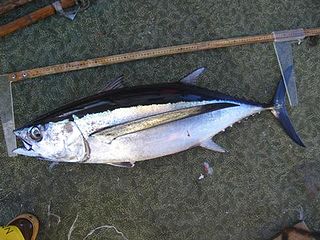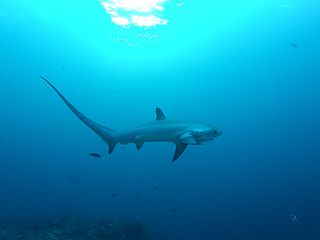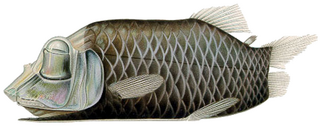
The albacore, known also as the longfin tuna, is a species of tuna of the order Scombriformes. It is found in temperate and tropical waters across the globe in the epipelagic and mesopelagic zones. There are six distinct stocks known globally in the Atlantic, Pacific, and Indian oceans, as well as the Mediterranean Sea. The albacore has an elongate, fusiform body with a conical snout, large eyes, and remarkably long pectoral fins. Its body is a deep blue dorsally and shades of silvery white ventrally. Individuals can reach up to 1.4 m in length.

Thresher sharks are large mackerel sharks of the family Alopiidae found in all temperate and tropical oceans of the world; the family contains three extant species, all within the genus Alopias.

Barreleyes, also known as spook fish, are small deep-sea argentiniform fish comprising the family Opisthoproctidae found in tropical-to-temperate waters of the Atlantic, Pacific, and Indian Oceans.

Pink salmon or humpback salmon is a species of euryhaline ray-finned fish in the family Salmonidae. It is the type species of the genus Oncorhynchus, and is the smallest and most abundant of the seven officially recognized species of salmon. The species' scientific name is based on the Russian common name for this species gorbúša (горбуша), which literally means humpie.

The largehead hairtail or beltfish is a member of the cutlassfish family, Trichiuridae. This common to abundant species is found in tropical and temperate oceans throughout the world. The taxonomy is not fully resolved, and the Atlantic, East Pacific and Northwest Pacific populations are also known as Atlantic cutlassfish, Pacific cutlassfish and Japanese cutlassfish, respectively. This predatory, elongated fish supports major fisheries.

The bigeye tuna is a species of true tuna of the genus Thunnus, belonging to the wider mackerel family Scombridae. In Hawaiian, it is one of two species known as ʻahi, the other being the yellowfin tuna. Bigeye tuna are found in the open waters of all tropical and temperate oceans, but not in the Mediterranean Sea.

The Lessepsian migration is the migration of marine species along the Suez Canal, usually from the Red Sea to the Mediterranean Sea, and more rarely in the opposite direction. When the canal was completed in 1869, fish, crustaceans, mollusks, and other marine animals and plants were exposed to an artificial passage between the two naturally separate bodies of water, and cross-contamination was made possible between formerly isolated ecosystems. The phenomenon is still occurring today. It is named after Ferdinand de Lesseps, the French diplomat in charge of the canal's construction.

The brownsnout spookfish or brown-snout spookfish is a species of barreleye in the family Opisthoproctidae. It and the glasshead barreleye fish are the only vertebrates known to employ a mirror, in addition to a lens, to focus an image in its eyes. This species probably has a worldwide tropical and temperate distribution; in the Atlantic Ocean it is known from Bermuda, the Bahamas, the Greater Antilles, and the Gulf of Mexico, and in the Pacific Ocean it is known from the California Current region and the South China Sea. It is found in the mesopelagic and bathypelagic zones at a depth of 500–2,400 meters (1,600–7,900 ft), but usually occurs below 1,000 meters. In the Gulf of Mexico it is found shallower, at 310–460 meters (1,020–1,510 ft).

Cirripectes vanderbilti, the scarface blenny, is a species of combtooth blenny found in coral reefs in the Hawaiian and Johnston islands in the eastern central Pacific ocean. This species reaches a length of 10 centimetres (3.9 in) SL. It is commonly confused with Cirripectes variolosus.

Dolichopteryx is a genus of barreleyes.
Zaniolepis frenata, also known as the shortspine combfish, is a species of ray-finned fish belonging to the family Zaniolepididae.The species occurs in the eastern Pacific Ocean.
Nikolai Vasilyevich Parin was a Soviet and Russian ichthyologist, specializing in oceanic pelagic fish. He headed the Laboratory of Oceanic Ichthyofauna at the RAS Institute of Oceanology in Moscow, where he ended his career as a Professor after more than fifty-seven years. In his career, he described more than 150 new taxa of fish and participated in 20 major oceanic expeditions. Thirty-six species of fish are named in his honour.
Dolichopteryx anascopa is a species of fish found in the sub-Antarctic waters of the Atlantic Ocean, the Indian Ocean and south-eastern Pacific Ocean.
Dolichopteryx minuscula is a species of fish found in the Indo-West Pacific including Mauritius and Japan.
Dolichopteryx rostrata is a species of fish found around the Hebrides Islands in the north-eastern Atlantic Ocean.
Dolichopteryx andriashevi is a species of fish endemic to in the Philippine Sea.
Dolichopteryx vityazi is a species of fish found in the Pacific Ocean.
Dolichopteryx trunovi, the tailspot barracudina, is a species of fish found in the oceans of the Southern hemisphere.
Dolichopteryx parini, the winged spookfish, is a species of fish found in the Pacific Ocean.








